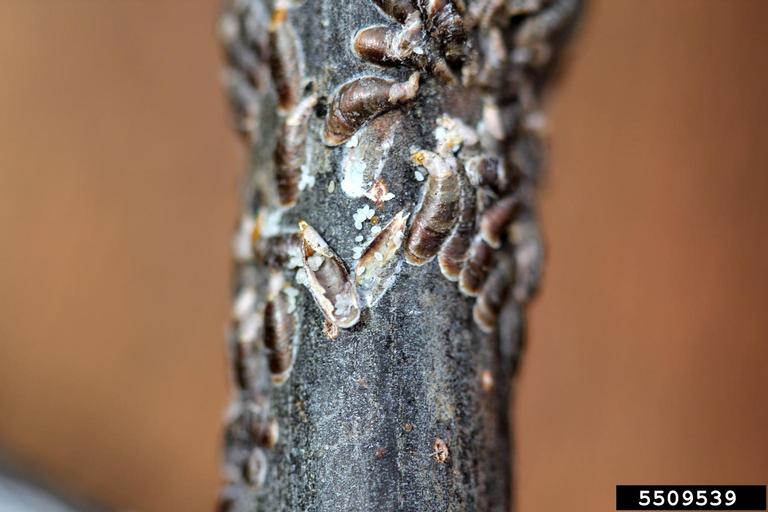
One of the most common tree diseases in Utah, oystershell scale can wreak havoc on aspen and spruce trees. Once infected, trees suffering from this disease should receive professional examination and treatment.
What Is Oystershell Scale?
Also known as Lepidosaphes ulmi, oystershell scale is a damaging tree disease that – you guessed it – looks like oyster shells. It develops on the bark of trunks and limbs, and can be found infecting aspen, spruce, poplars, ash, willow, cotoneaster and lilac.
While oystershell scale looks like in infection, it is actually an insect infestation. Brown or gray, and about 1/8-inch long, full-grown female scales are the most commonly observed oystershell scales. The insect’s lifecycle is a year-long process, in which the winter is spent in the egg phase. The eggs hatch over a two to three-week period in late May or early June, and the nymphs – called crawlers – colonize nearby trees. The scales reach maturity mid-summer and lay eggs in the late summer or early fall. The mother scale dies at the end of the season and provides a protective waxy covering for her egg throughout the winter.
Growing oystershell scales feed on a tree’s fluids and sap through the bark on its trunk and limbs. Scale damage weakens trees, making them more susceptible to other tree pathogens.
How Do You Prevent Oystershell Scale?
Unfortunately, oystershell scale has few natural enemies. Predatory mites feed on overwintering eggs and Cytospora-damaged limbs can kill maturing oystershell scales and overwintering eggs. These natural enemies, however, trade one problem for another.
While they may kill off the scale, they can also further damage and kill a tree.
It’s been regularly observed that only one or two trunks in ornamental clump plantings are typically infested while the rest appear to resist the insects. The commonly accepted conclusion from this observational data is that vigorous tree growth from proper care may help reduce oystershell scale.
What Is the Best Oystershell Scale Treatment?
Due to the scale insects’ coloring and shape, oystershell scale easily blends into the bark of many trees. As such, it’s very common for the scales and injury symptoms to go unnoticed. Once infected, trees may require the following oystershell scale treatments.
Hand Removal
For smaller trees, the mature oystershell scale and eggs can be removed by gently scrubbing the tree’s bark with a soft plastic pad. Severely infected branches, however, require pruning for proper removal.
Crawler Sprays
Timing is very important when it comes to oystershell scale treatment, as oystershell scale is extremely vulnerable during the crawler period of its lifecycle. During this time, the scale is small and does not yet have its waxy protective cover. While the scale is in its crawler phase, many commonly-used insecticides can be effective.
Determining when the scale is in this stage requires an experienced examination of the tree. While timing varies from season to season, professional arborists typically begin examinations around mid-May.
Summer Season Oil Sprays
Typically used as post-crawler sprays, these sprays can be effective in the younger stages of oystershell scale while the insect has minimally developed wax covers.
Dormant Season Oil Sprays
Dormant season oil sprays are used during the overwintering egg stage of oystershell scale. While these sprays can kill many of the overwintering eggs, the oils won’t penetrate the now-dead mother’s waxy cover to reliably kill all of the eggs. Dormant season oils are used more as management tool and other oystershell scale treatments are typically required.
If you have a tree exhibiting signs of oystershell scale infestation, contact your local arborist for an examination and treatment. The sooner the infestation is caught, the better for the health of the tree.
Photo credit: Whitney Cranshaw, Colorado State University, Bugwood.org




